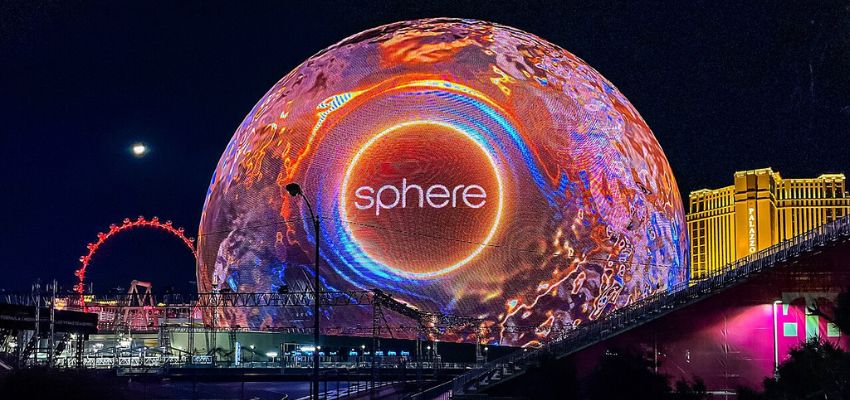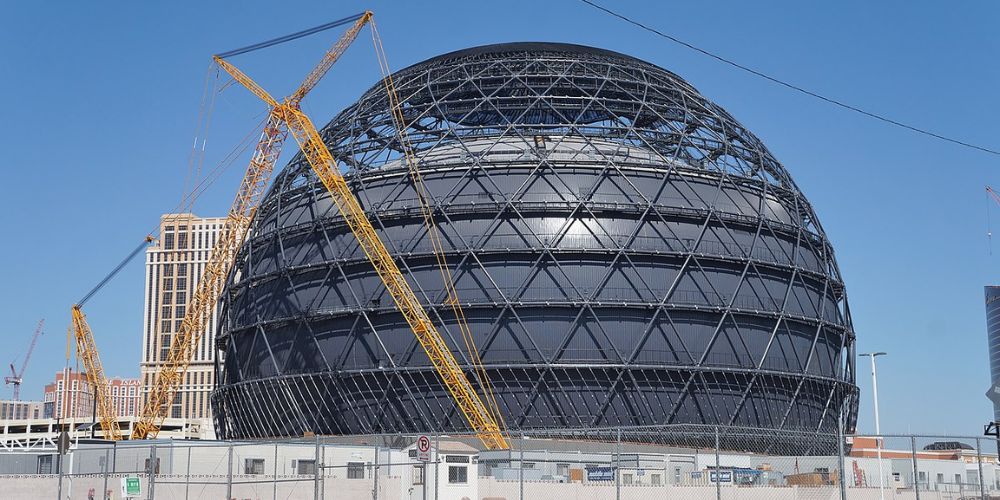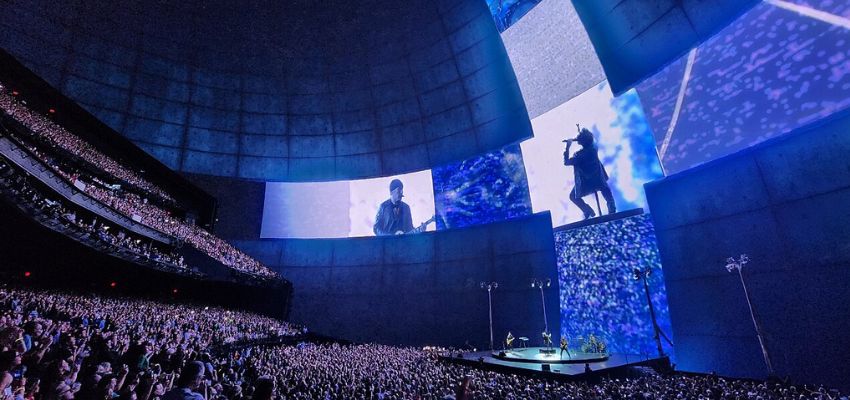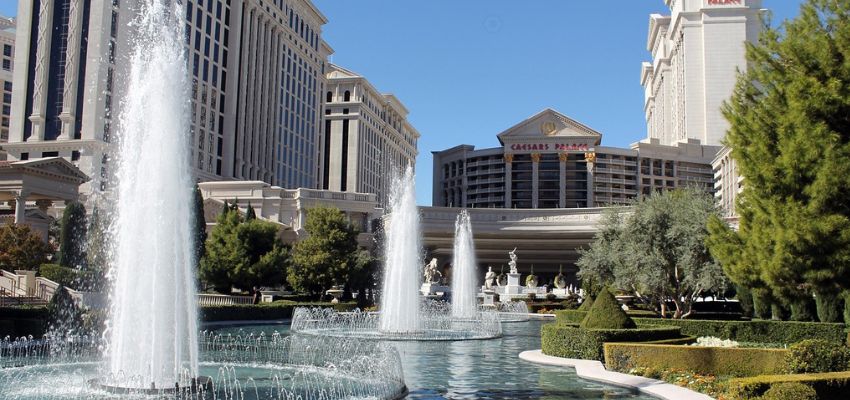The Las Vegas Sphere Unveiled: 16 Fascinating Facts that Will Boggle Your Mind

Of all the new things Las Vegas welcomed in 2023, the MSG Sphere tops the list as the most show stopping, gag-worthy addition to the Strip. And it’s not hard to see why—standing 366 feet tall and stretching 516 feet wide, the Sphere is the largest spherical building in the world, featuring some of the world’s most sophisticated audio and visual technology.
Located just off the Strip east of the Venetian and Palazzo, this other-wordly new concert venue, event space, and interactive experience is the subject of much fascination for Vegas die-hards, tech lovers, and just about anyone else who finds themselves standing in its shadow—including us!
So is the MSG Sphere really worth all the hullabaloo?
The short answer is yes, yes it is. The long answer? Keep reading.
There’s no doubt about it—the Sphere is a mind-boggling achievement in architecture and technology. But what exactly makes it so astounding? We’ve scoured the internet and compiled a list of 16 of the most fascinating facts about the MSG Sphere, from construction to immersive features to ad sales.
Let’s jump in.

Construction
It’s no easy task constructing one of the most extraordinary buildings in the world! Here are four interesting facts about the Sphere’s construction:
- The Sphere was built by the group behind Madison Square Garden (hence “MSG”), and is owned by the same guy who also runs the New York Knicks and New York Rangers.
- The site was provided by The Sands. Approximately 110,000 cubic yards of dirt and rock were excavated to prepare the site for construction!
- Construction required the 4th largest crane crawler in the world. Brought in from Belgium, the crane alone required 120 tractor-trailers to transport to Vegas, and it took 18 days to assemble using a separate secondary crane. Once construction of the dome trusses reached their midway point, the crane had to be moved to the southern side of the property to install the remaining trusses. This relocation alone took 2 days!
- 6,000 cubic yards of concrete were pumped into the roof once the steel frame was completed, forming a layer 10” thick weighing approximately 10,000 tons.

Size
We know the Sphere is the largest spherical building in the world, stealing this honor from Stockholm’s Avicii Arena—but just how big is it, exactly?
- The Sphere measures 366 feet tall and 516 feet wide at its widest point.
- The Sphere could easily hold the entire Statue of Liberty, from base to torch.
- With 875,000 square feet of space, the Sphere has an interior capacity of 18,600 seats and standing room for 20,000 people.
- The exosphere is 30% taller than the interior dome. The dome’s roof required 3,000 tons of steel to construct, and includes 32 trusses that weigh a whopping 100 tons each. It weighs a total of 13,000 tons, with a surface area of 220,000 square feet.

The Immersive Experience
The Sphere is more than just a, well, eye-catching spherical building—it’s home to some of the world’s most advanced immersive technology, from record-setting screens to cutting-edge audio.
- Out of 18,600 total seats, 10,000 seats provide a fully immersive experience, including specialized sound systems, haptic seats capable of making guests “feel” sound vibrations, and 4D machines that create wind, temperature, and scent effects.
- The exterior display is made up of over 1.2 million programmable LEDs, featuring about 580,000 square feet of programmable lighting. The Sphere’s owners say you can see it from space!
- Manufactured by Canadian company SACO Technologies, the interior high-resolution LED screen is the largest on earth, wrapping halfway around the 18,600 seats inside. It measures 160,000 square feet and covers an area larger than three football fields!
- The interior screen also features 268 million video pixels with 16K resolution, making it the highest resolution screen in the world—at 19,000 x 13,500 pixels, it’s 100x clearer than today’s best HD TVs.
- The Sphere is home to the world’s largest concert-grade audio system, comprising 1,586 loudspeaker modules, 167,000 speaker drivers, amplifiers, and processing channels, as well as 300 mobile loudspeaker modules that deliver a “crystal-clear” multi-layered audio experience through “beamforming” technology and wave field synthesis.
- A one-week advertising campaign could set brands back a whopping $650,000. A one day campaign (which works out to about four hours of screen time) will run $450,000.
Wait up—what is beamforming and wave field synthesis?
Beamforming and wave field synthesis are audio signal processing techniques that create a more immersive sound experience:
- Instead of trying to cover as wide an area as possible, beamforming aims to place sounds at very specific points in space. Compared to traditional speakers, beamforming is like using a paintbrush instead of a roller.
- Wave field synthesis is a spatial audio rendering technique that places virtual sound sources in real space by producing “artificial” wave fronts that are synthesized by a number of individually driven speakers.
Energy Consumption
- The Sphere requires 28 megawatts to function at peak energy usage, the equivalent to supplying power to 21,000 homes.
- Around 70% of the Sphere’s energy will be obtained from solar power!
Visiting The Sphere
The Sphere may have opened with a 36-date residency by megarockers U2, but this iconic addition to the Strip isn’t just for concerts.
The Sphere plans to host 4-6 residencies per year (Phish is up next, starting in April 2024), but when it’s not functioning as a concert venue, it transforms into the fully immersive “Sphere Experience”.
The inaugural Sphere Experience features a 50 minute short multi-sensory film called “Postcard From Earth”, created by Darren Aronofsky (director of Black Swan). In Aronofsky’s words, Postcard From Earth will take you on a journey “deep into our future as our descendents reflect on our shared home”, complete with 4D technology and haptic seats.
And if the ground-breaking Postcard from Earth short film isn’t enough, the Sphere Experience also includes unique holographic art installations, the opportunity to capture and create your own 360-degree virtual avatar, and even meet Aura. Described as the “world’s most advanced humanoid robot”, Aura is an android that uses AI to communicate with guests. There are five Auras to interact with while you visit, each representing a different topic: productivity, connection, innovation, longevity, and creativity.
Admission to the Sphere Experience starts at $69 per person. For an extra fee, you can reserve the best seats in the house, or upgrade to a premium suite for the ultimate Sphere experience.
CANYON TOURS TIP: For the best views, book seats above the 100-level.
Wrapping Up
From its awe-inspiring construction to next-level immersive features, the Sphere’s record-breaking size and cutting-edge audio-visual technology make it a standout attraction on the Strip. Whether you’re a Vegas enthusiast, tech aficionado, or just curious, the Sphere is, without a doubt, worth the hype.
Plan your visit, buy tickets, and more on the Sphere’s website.

